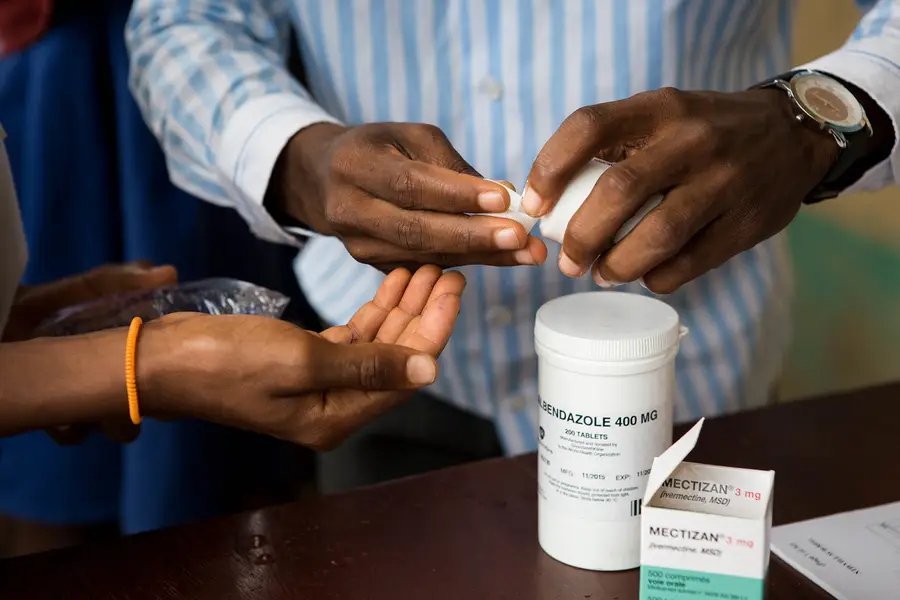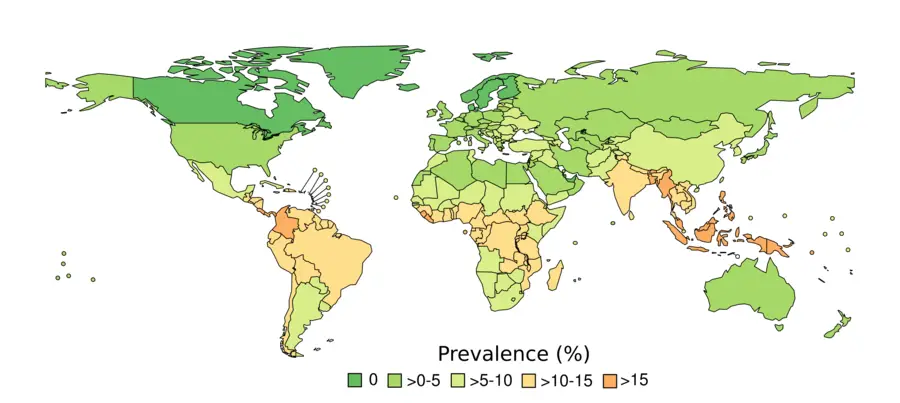Students at a primary school in Cross River State, Nigeria receive medicines for NTDs during a mass drug administration. Photo Credit: Ruth McDowall / RTI International
When you hear the name strongyloidiasis, you likely think of an obscure disease in a far-off land. In fact, until recently, it was considered one of the most neglected of the neglected tropical diseases (NTDs), a set of debilitating parasitic and bacterial diseases that cause severe disability and affect more than one billion people around the world. What you might not have guessed, though, is that this treatable disease caused by an intestinal worm has also been found in parts of the southern United States, and that it is much more widespread than previously thought.
What is Strongyloidiasis?
Strongyloidiasis is an infection caused by the parasitic worm (also known as a soil-transmitted helminth) Strongyloides stercoralis. It is transmitted through contact with contaminated soil and thrives in areas with warm and moist climates with poor sanitation. Symptoms can include hives, abdominal pain, and diarrhea, and lead to a fatal syndrome in immunosuppressed individuals. It also can cause nutritional issues and stunting in children, which impacts their cognitive and physical development and can have lifelong effects on education and income.
If gone untreated, the parasite stays with you your whole life. Unlike other intestinal worms, however, there are currently no large-scale programs designed to distribute medicines and treat this disease, due in large part to a previous underestimation of the disease’s prevalence.
Strongyloidiasis Prevalence
So, how widespread is strongyloidiasis globally? And what is needed to implement large-scale programming to control this disease?
We set out with a team of researchers from the World Health Organization (WHO) and the IRCCS Ospedale Sacro Cuore Don Calabria Hospital in Italy to fill this knowledge gap in two papers, “The Global Prevalence of Strongyloides stercoralis Infection,” and “Preventive chemotherapy for the control of strongyloidiasis in school-age children: Estimating the ivermectin need.”
In the first paper, our aim was to obtain a more accurate estimate of the global burden of this disease with data at the country level. Previous studies estimated that 30-100 million people were infected, but these estimates had been questioned due to an unclear source and methods as well as diagnostic performance issues. One key challenge in estimating the prevalence of this disease is that it is difficult to diagnose—none of the diagnostic tests that exist for other worm infections are considered a gold standard for strongyloidiasis.
We conducted a literature review and identified 146 articles with prevalence data from 1990 - 2016 from across 43 countries, then used a spatiotemporal statistical modeling approach to estimate the prevalence at the global and country level in 2017. Our analysis included high-, middle- and low-income countries.
What we found was surprising – not only were our findings significantly different from what had previously been found – they were nearly 10 times larger, with our estimates at 613.9 million people infected worldwide.
We also found that East Asia, sub-Saharan Africa, and Latin America accounted for 76.1% of the global infections. We believe these estimates can be used to identify countries in which prevalence is the highest and where treatment campaigns should be deployed for prevention and control. Due in part to these and similar findings, the World Health Organization (WHO) recently included strongyloidiasis in its 2021-2030 NTD Roadmap, recommending the implementation of control programs for school-age children and signaling an important first step in confronting this neglected disease.
Estimated strongyloidiasis prevalence for 2017, as predicted by the best statistical model.
Interventions for Strongyloidiasis
Those of us that work with NTDs know that deworming programs in schools are a low-cost, high-impact intervention. More broadly, interventions to prevent and control NTDs are one of the “best buys” in global public health, yielding an estimated net benefit to affected individuals of about US$25 per US$1 invested in preventive chemotherapy.
Although there is also a large burden of strongyloidiasis among adults, school-based treatment programs represent the best opportunity to begin control activities now, since many countries already have the frameworks in place for deworming. Recent findings suggest that the geographical distributions of strongyloidiasis and hookworm not only overlap in many countries, but follow a defined correlation, meaning that integrating treatment for strongyloidiasis into hookworm control programs in schools would take advantage of existing infrastructure and logistics and provide cost-savings.
Given the prevalence of strongyloidiasis and the benefits of school-based treatment programs, we set out in a second paper to estimate the amount of ivermectin - the main medicine that has proven to be effective against strongyloidiasis - that would be needed to integrate treatment for strongyloidiasis into existing deworming programs for school-age children.
The target population for our study was school-age children between the ages of five and 15 living in 97 countries where the WHO has indicated deworming programs are needed. We used national level strongyloidiasis prevalence numbers from these countries, as well as population data from 2018 to calculate our estimates. We found that between 161 million and 284 million school-age children should be enrolled in deworming campaigns to reduce the prevalence of strongyloidiasis.
It is important to note that both of our studies used country level data, so more surveys should be conducted in specific areas where prevalence is estimated as high prior to designing integrated deworming programs. In the past, a generic form of ivermectin was not easily available, limiting the expansion of strongyloidiasis treatment programs due to high drug costs. However, a new generic form of ivermectin was recently added to the WHO list of prequalified medicines and will be available at preferential prices for large scale programs. Thus, we hope that our findings will help countries begin to appraise the cost constraints and benefits to implementing treatment programs.
Strongyloidiasis can be a debilitating disease that affects the health and development potential of more than half a billion people worldwide, but it is easily curable with the right medicine. It is critically important that implementers, researchers, donors, governments, and pharmaceutical companies come together to utilize the NTD mechanisms already in place in many low- and middle-income countries to address this parasitic worm and ensure healthy and productive lives for millions. The time to act is now.
Learn more about our work with neglected tropical diseases.




